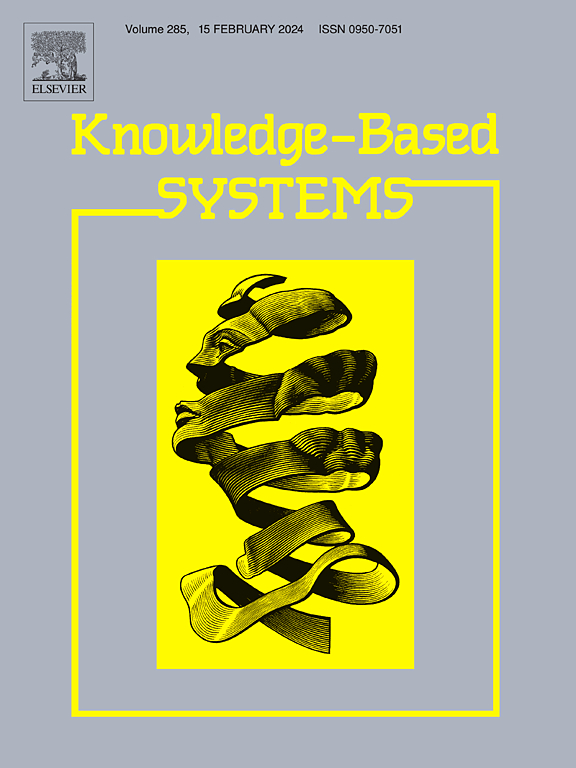Dual semi-supervised hypergraph regular multi-view NMF with anchor graph embedding
IF 7.2
1区 计算机科学
Q1 COMPUTER SCIENCE, ARTIFICIAL INTELLIGENCE
引用次数: 0
Abstract
Graph regularized nonnegative matrix factorization (GNMF) has been widely used in multi-view clustering tasks due to its good clustering properties. However, it uses a simple graph to describe the complex data relationship of multiple views and tries to obtain a consistent low-dimensional representation, which undoubtedly brings challenges to its clustering performance. In addition, clustering a large amount of high-dimensional data from multiple views undoubtedly faces a huge computational burden. In order to effectively improve the performance and efficiency of GNMF based multi-view clustering algorithm, this paper proposes a dual semi-supervised hypergraph regular multi-view clustering method with anchor graph embedding (DSSHMNMFAE). Specifically, DSSHMNMFAE develops a new anchor selection method to generate anchors and the anchor bipartite graph is constructed to embed the matrix factorization process. DSSHMNMFAE constructs a hypergraph to effectively learn the high-order relationship between data from multiple views. In order to perform semi-supervised learning more efficiently, DSSHMNMFAE integrates pairwise constraint information and label constraint information into the clustering process as dual label information. In addition, DSSHMNMFAE considers the learning of both consistency information and complementarity information, and adopts adaptive measures to distinguish the contributions of different views. We use the alternating iterative algorithm to optimize the objective function of DSSHMNMFAE. The experimental results on eight real datasets show that the performance of DSSHMNMFAE is comparable to other algorithms.
带锚图嵌入的双半监督超图正则多视图 NMF
图形正则化非负矩阵因式分解(GNMF)因其良好的聚类特性已被广泛应用于多视图聚类任务中。然而,它使用简单的图来描述多视图的复杂数据关系,并试图获得一致的低维表示,这无疑给其聚类性能带来了挑战。此外,对来自多个视图的大量高维数据进行聚类无疑面临着巨大的计算负担。为了有效提高基于 GNMF 的多视图聚类算法的性能和效率,本文提出了一种带锚图嵌入的双半监督超图正则多视图聚类方法(DSSHMNMFAE)。具体来说,DSSHMNMFAE 开发了一种新的锚选择方法来生成锚,并构建了锚双方图来嵌入矩阵因式分解过程。DSSHMNMFAE 构建了一个超图,以有效学习多视图数据之间的高阶关系。为了更有效地进行半监督学习,DSSHMNMFAE 将成对约束信息和标签约束信息作为双标签信息集成到聚类过程中。此外,DSSHMNMFAE 还考虑了一致性信息和互补性信息的学习,并采用自适应措施来区分不同观点的贡献。我们采用交替迭代算法来优化 DSSHMNMFAE 的目标函数。在八个真实数据集上的实验结果表明,DSSHMNMFAE 的性能与其他算法相当。
本文章由计算机程序翻译,如有差异,请以英文原文为准。
求助全文
约1分钟内获得全文
求助全文
来源期刊

Knowledge-Based Systems
工程技术-计算机:人工智能
CiteScore
14.80
自引率
12.50%
发文量
1245
审稿时长
7.8 months
期刊介绍:
Knowledge-Based Systems, an international and interdisciplinary journal in artificial intelligence, publishes original, innovative, and creative research results in the field. It focuses on knowledge-based and other artificial intelligence techniques-based systems. The journal aims to support human prediction and decision-making through data science and computation techniques, provide a balanced coverage of theory and practical study, and encourage the development and implementation of knowledge-based intelligence models, methods, systems, and software tools. Applications in business, government, education, engineering, and healthcare are emphasized.
 求助内容:
求助内容: 应助结果提醒方式:
应助结果提醒方式:


